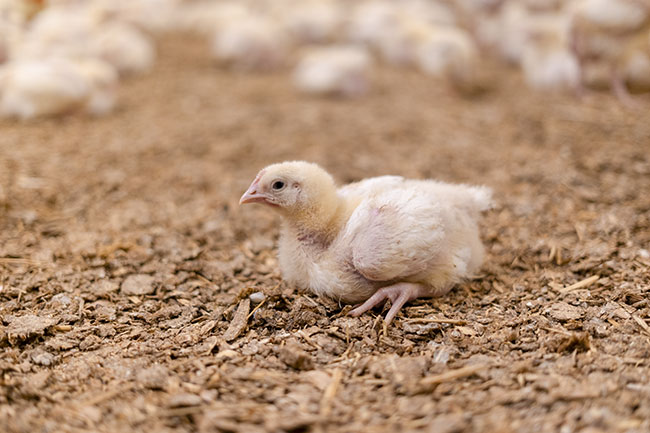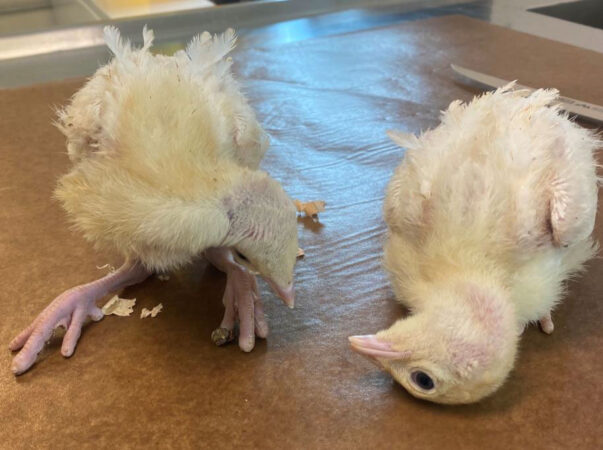
National poultry health update
By Lilian Schaer
Features Disease watchBefore avian influenza struck again in the fall, bacterial challenges were the dominate poultry health issue in 2023. Here's a look back.
 Birds now being affected by E. cecorum at a younger age and showing more severe symptoms.
Photo: EW Nutrition
Birds now being affected by E. cecorum at a younger age and showing more severe symptoms.
Photo: EW Nutrition In many ways, 2023 will be remembered as the year of the usual suspects where poultry health is concerned. That’s according to two veterinarians who spoke at the annual Poultry Service Industry Workshop this past fall: Dr. Gigi Lin, an independent B.C. practitioner at the time, and Dr. Jessalyn Walkey of Production Poultry Veterinary Services in Ontario.
“There hasn’t been much emerging disease across all commodities, and also a relatively stable year for natural disasters like heat and flooding,” says Lin, who provided a Western Canadian perspective. “Things have been quite stable – when a veterinarian says it’s been a boring year, that’s a really good thing!”
According to Lin, the year did start with higher than usual early mortality in chicks and poults, but that was likely because of chick quality issues and a shortage of supply due to avian influenza. It was an issue that was essentially resolved by the third quarter of the year.
“The biggest issues year over year continue to be bacterial. The major diseases may shuffle through the top positions, but bacterial challenges continue to be the dominant source of the top one or two health issues,” adds Walkey, who addressed trends in Ontario, Quebec, and Atlantic Canada. “That’s the context I’m seeing from the provinces I was representing.”
Turkeys
Leading the way for turkeys as a top issue were bacterial infections like E. coli, E. cecorum, C. perfringens and others in both eastern and western Canada, resulting in septicemia and other health challenges.
Another common thread in turkeys were birds presenting with neurological symptoms, leaving them weak and with necks twisted backwards and unable to coordinate movements. This was reported in all four western provinces, as well as Ontario and Quebec.
Tissue samples showed inflammation in the brain, but subsequent testing was negative for avian encephalomyelitis (AE), as well as Newcastle, avian influenza, and viral diseases with neurological symptoms.
Some cases resulted in very high mortality rates of five to 30 per cent. A few birds were found to subsequently develop lameness with lesions in the heart and tendons consistent with reovirus.
“The only positive test was for reovirus in some cases, which we saw in Western and Eastern Canada and from some U.S. practitioners as well,” notes Lin, who adds neurological reovirus had previously only been reported in broilers in recent years. “There are many different diagnoses for poults with neurological symptoms. So, it’s important that growers work with their vets to submit birds to labs for accurate diagnosis.”
Broilers
Inclusion body hepatitis (IBH) continues to be one of the most common broiler diseases veterinarians see in broiler chickens across Canada. Infectious bronchitis and bacterial challenges caused by E. coli, E. cecorum, Salmonella and others also persistently cause problems for producers.
“IBH was a major challenge for Ontario this year, reaching anywhere from moderate to severe mortality,” Walkey notes. “In Quebec, the number of clinical cases has decreased but we are seeing the IBH cases in older birds in the 28-to-35-day range.”
According to Lin, B.C. has started seeing a rise in infectious bronchitis cases over the last two or three years during seasonal temperatures changes in fall and winter. It can result in a sudden, acute increase in mortality during the last few weeks of production or extremely high condemn rates of up to 20 percent due to airsacculitis.
“Infectious bronchitis is highly contagious, and we see new variants often,” Lin says, adding the virus can cause respiratory, renal, or reproductive issues. “Vaccination is one (control) strategy; also, work on ventilation and tighten up biosecurity to minimize the impact.”
Broiler breeders
Disease trends for broiler breeders have remained relatively status quo this past year. Infectious bronchitis has contributed to sudden mortality spikes, decreased production and cystic oviducts in Ontario. What’s more, Atlantic Canada reported challenges with IBH in the winter and spring months.
In B.C, Alberta, and Manitoba, Staphylococcus arthritis has become a common infection in broiler breeders, resulting in joint, tendon, bone, and foot pad infections. It’s a painful condition that causes welfare issues and can lead to increased mortality and culling.
Layers
Alberta reported cases of focal duodenal necrosis, which were also seen in Ontario. Additionally, B.C., Alberta and Manitoba all had problems with egg drop. Meanwhile, Atlantic Canada, Ontario and Quebec dealt with issues related to infectious bronchitis. Layer flocks in Quebec were also challenged with avian encephalitis, resulting in a 15 per cent drop in egg production.
“There can be many things that cause a drop in egg production; the bottom line is to make an accurate diagnosis, so you know what you have and how to treat it,” Lin says. “Keep good records, and keep your vaccine program current. It is hard to do a good disease investigation if you have incomplete data or records.”
Additional challenges in Eastern Canadian layer flocks included a rise in fatty liver syndrome, ammonia blindness in eight-week-old layer pullets and cage layer fatigue reported in Atlantic Canada.

A common thread in several provinces in 2023 were turkeys presenting with neurological symptoms, leaving them weak and with necks twisted backwards.
What’s old is new
E. cecorum and necrotic enteritis are two bacterial conditions that aren’t new to the poultry industry. What is new, however, is that they’re becoming more common and more challenging to deal with, something Walkey believes could be exacerbated by the demands modern production is placing on the birds.
“As we try to meet the asks of our (production) system, like new genetics or reduced antibiotics, the energy it takes a bird to reach its full performance potential isn’t guaranteed,” she explains.
“To be able to perform in the presence of challenge or disease demand is not new, but the ask of the bird is getting taller. As tools are shifting and diseases are becoming more prevalent, we have to be realistic about what the birds are up against and how those diseases can and are impacting them.”
Avian influenza
Highly pathogenic avian influenza (HPAI) continues to be a challenge for poultry producers across Canada, albeit at different times and to varying degrees. For Lin, a positive outcome has been more and better communications between veterinarians, and many new opportunities to educate growers, allied industries, veterinarians, and academics in the fundamentals of prevention and control.
It’s a perspective shared by Walkey, who believes that although the industry can’t control the wind, producers can stay informed to influence other variables that can help keep flocks healthy.
“I’m very pleased with how information is being distributed for producer awareness. People are always hungry for more info and want to stay connected. This is something that knows no bounds, so we have to work together,” she says.
“There is a big focus on biosecurity and my job is to be able to help spread the information and make sure that we can help if there are practices that need to be tweaked.”
Print this page